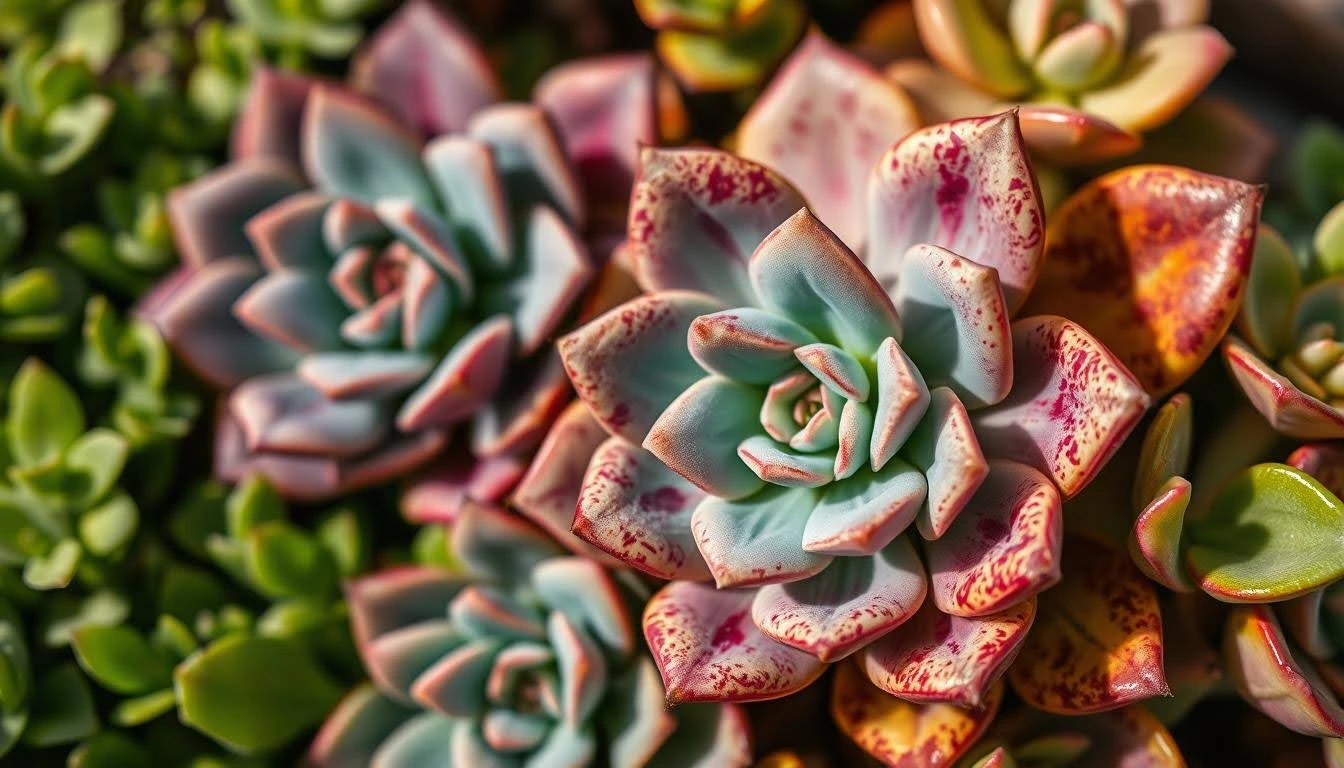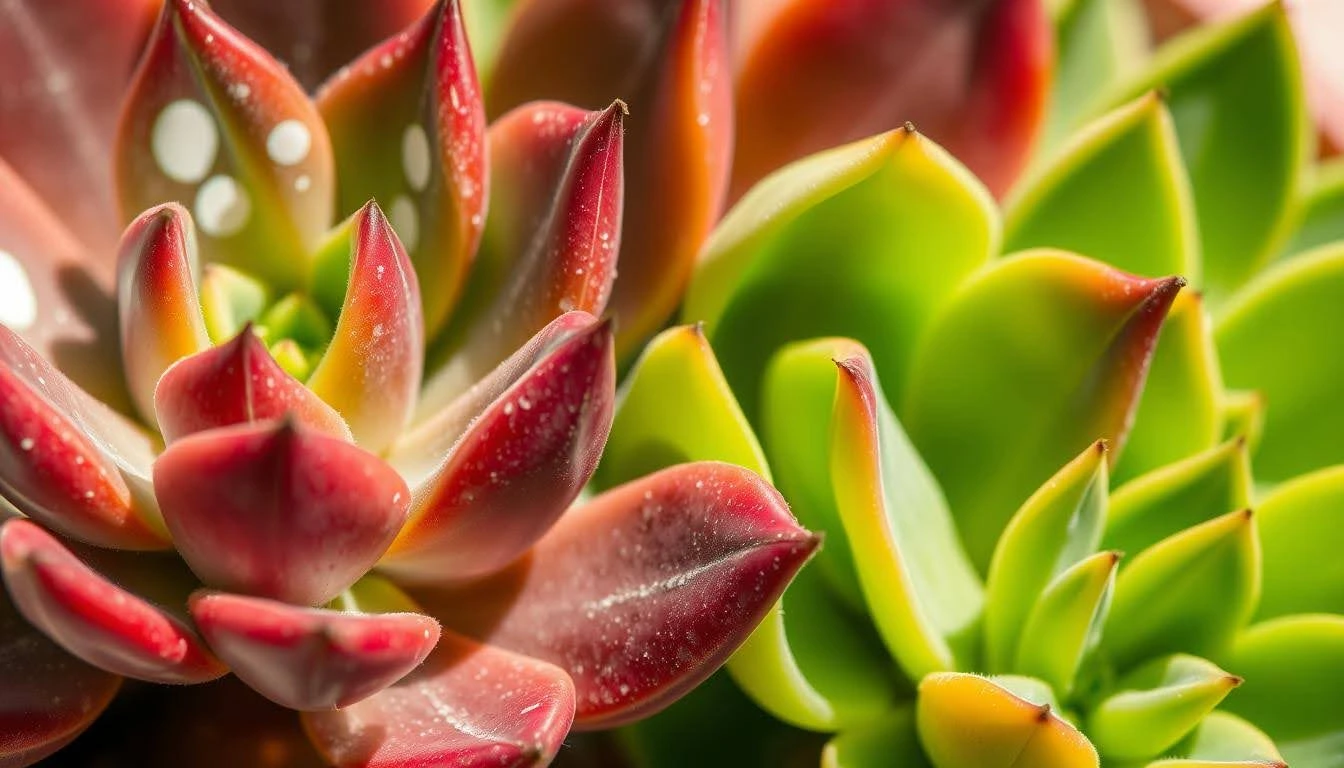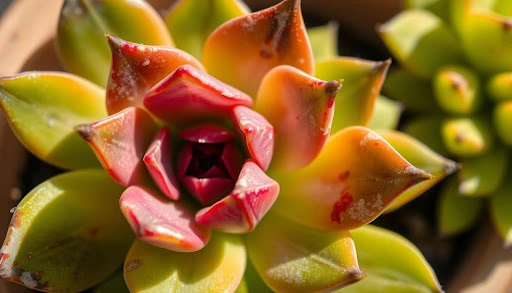My sunburn succulent white spots turned purple and I had no idea what went wrong.
I thought I was giving my succulent the perfect sun-kissed glow—until I noticed something alarming.
At first, tiny white spots dotted its once-lush leaves, like flecks of dust caught in the sunlight.
Within days, those spots deepened into an eerie shade of purple. Panic set in.
Had I damaged my plant beyond repair?
This sudden transformation left me searching for answers.
Was it stress? A cry for help? Or was my succulent adapting in ways I didn’t understand?
When my sunburn succulent white spots turned purple, I realized this wasn’t just a problem—it was a warning sign.
With the proper care, I figured out how to fix the damage, bring my plant back to life, and stop future sun stress.
If you’re dealing with a similar problem, here’s everything you need to know to revive your succulent.
Understanding My Sun Burn Succulent White Spots Turned Purple
When succulents get too much sun, they might start with white spots.
These spots can turn purple or brown, showing they’re stressed.
This is a sign that your plants are struggling with too much sun.
The change from white to purple spots is a big deal for succulents.
It means the plant has been hurt badly by the sun.
Knowing this helps you spot sunburn and help your plants get better.
Succulents can bounce back from sun damage with the proper care.
Spotting sunburn early, from white spots to purple, helps them recover.
This way, you can help your plants get back to their best.

It is important to keep an eye on your succulents and learn about sun damage.
With the right knowledge, you can help your stressed succulents recover.
They can even get back to their vibrant colors after turning purple.
Common Signs of Sunburned Succulents
Knowing how to care for sunburned succulents starts with spotting the signs of sun damage.
You might first see white spots or patches on the leaves, showing mild sunburn.
If the damage worsens, these spots can turn purple or brown, showing more serious sunburn.
Initial White Discoloration
The first sign of succulent sunburn is white spots or discoloration on the leaves.
This is the plant’s way of saying it’s getting too much light. It’s essential to act fast to stop more damage.
Progression to Purple and Brown Spots
As sunburn gets worse, white spots can turn purple or brown.
These signs mean the plant is struggling with the light. It needs quick help to avoid lasting damage.
Texture Changes in Leaves
Sunburned succulents also show changes in leaf texture.
Affected areas might become soft, shriveled, or even crispy.
This is because the plant’s tissues get damaged by too much sun.
Spotting these signs is key to caring for sunburned succulents.
Acting early can help your plants recover and avoid further harm.

Why Succulents Get Sunburned: Environmental Factors
Succulents can get sunburned due to environmental factors.
The main reason is sudden exposure to intense sunlight.
This can happen when they move from low light to bright light.
Changes in where they grow can also cause sunburn.
Moving them indoors or outdoors or from shade to sun can shock them.
Succulents do best with slow changes in their environment.
High temperatures and intense sunlight increase the risk of succulent stress colors and sun protection for succulents—most succulents have temperatures between 60 and 90 degrees Fahrenheit.
But, temperatures over 90 degrees can harm them, causing color and texture changes in their leaves.
| Environmental Factor | Impact on Succulents |
| Sudden Sunlight Exposure | Leads to white or purple spots (sunburn) |
| Changes in Growing Conditions | Triggers stress response and sunburn |
| High Temperatures | Increases risk of sunburn and discoloration |
Knowing these environmental factors is key to protecting your succulents.
You can prevent sunburn by watching their light, temperature, and acclimation needs.
This way, your succulents will thrive in any setting.

The Role of Light Exposure in Succulent Health
Light is key for succulent health. These plants love bright light but need the right amount.
Knowing about direct and indirect sunlight, seasonal changes, and indoor vs. outdoor needs helps prevent sun damage, ensuring your succulents stay healthy and thrive.
Direct vs. Indirect Sunlight
Succulents are tough but can get sunburned by too much direct sunlight.
This can make their leaves pale, curled, or shriveled. While some recover, severe damage can leave lasting scars and slow growth.
Seasonal Light Changes
The light your succulents get changes with the seasons. In summer, they need more shade to avoid sunburn. In winter, indoor plants may need more sunlight to stay healthy.
Indoor vs. Outdoor Light Requirements
Indoor succulents need different light than those outside.
They might need extra light or be moved more often to get enough.
Outdoor plants can handle more sunlight but need to get used to it slowly.
Knowing how light affects your succulents helps you care for them better.
Adjusting to the seasons and watching their light needs is essential.
This way, your plants will stay vibrant and healthy, whether inside or outside.

Temperature Impact on Succulent Sunburn
Temperature is key in how likely succulents are to get sunburned. High heat, combined with strong sunlight, raises the risk. Moving succulents from cool places to hot, sunny spots can harm them.
Understanding succulent stress colors and sun protection is vital for succulents. It helps them adjust to new environments safely, ensuring they stay healthy and strong.
| Environmental Factor | Impact on Sunburn Risk |
| High Temperatures | Increases susceptibility to sunburn, when combined with intense sunlight |
| Sudden Temperature Changes | Sudden shifts from cool to hot can make succulents more prone to sunburn |
| Acclimation Period | Slowly getting used to new light and temperature helps prevent sunburn |
Knowing how temperature affects succulent stress colors and sun protection for succulents is key.
It helps you care for them better.
This keeps your succulents healthy and strong for a long time.

“Sunburn damages parts of the plant with chlorophyll, reducing the area available for photosynthesis.
A plant’s ability to recover from sunburn depends on factors like the extent of leaf damage and the health of its root system.”
How Growing Conditions Affect Succulent Sensitivity
Caring for sunburned succulents means knowing how their growing conditions affect sun damage.
Plants grown in greenhouses or indoors may get sunburned easily when moved outside.
This is because they’re not used to the strong sunlight.
Greenhouse vs. Home Environment
Succulents grown indoors or in greenhouses have thin leaves.
They are not ready for direct sunlight, and moving them to a sunny spot can cause sunburn.
Slowly getting them used to more light is essential.
Watering Schedule Importance
How often you water your succulents is key to avoiding sunburn.
Dry plants can’t handle the sun’s heat and light, but watering them regularly helps them stay healthy and strong.
Soil and Container Considerations
The soil and container your succulents use matter, too. They need soil that drains well but keeps some moisture. Containers that get too hot can also cause sunburn. Choosing the right soil and container helps your succulents thrive.
| Factor | Impact on Sunburn |
| Greenhouse vs. Home Environment | Greenhouse-grown succulents are more sensitive to sudden outdoor sun exposure |
| Watering Schedule | Underwatered succulents are more prone to sunburn |
| Soil and Container Type | Well-draining soil and containers that don’t absorb excessive heat are better for sunburned succulents |
Knowing how growing conditions affect succulents helps gardeners care for them better.
This way, they can help sunburned succulents recover and stay healthy.
Recovery Process for Sunburned Succulents
Reviving sunburned succulents is a careful process.
With the proper care and patience, they can heal and look vibrant again.
The key is to slowly help them get used to the right amount of light.
First, move the plants to a shaded spot away from the direct sun.
This will prevent further damage and allow them to start healing.
Then, check how bad the sunburn is. If it’s awful, remove damaged leaves.
This will help the plant grow new, healthy parts.
- Change how you water them to help them recover. Keeping the soil moist but not too wet can stress them out.
- Slowly let them get sunlight again, a little more each week. This helps them get used to it again.
It might take weeks to recover fully, and some leaves might not look the same.
But they can get better and look healthy again with the proper care.
Remember, being patient is essential. Hurrying can make things worse.
| Succulent Species | Sunburn Recovery Potentia | Key Considerations |
| Lithops | Lower | Require careful acclimation and monitoring |
| Pleiospilos Nelii | Higher | Bounce back well with proper care |
| Cacti | Higher | Recover well if roots remain undamaged |
Following these steps and knowing what different succulents need can help your sunburned succulents improve.
They will look vibrant and healthy again.
Preventing Future Succulent Sunburn
To avoid sunburn, it’s important to protect your succulents from the sun’s strong rays. You can do this by using the right acclimation techniques and managing shade well.
Proper Acclimation Techniques
When moving your succulents to a brighter spot, do it slowly. Give them more sunlight over weeks. This helps them get used to the new light without getting burned.
Start by putting them in a partly shaded spot. Then, slowly move them to more direct sunlight.
Shade Management Strategies
Use shade cloth or natural barriers like trees to protect your succulents.
This keeps them safe from the sun’s strongest rays and helps maintain the right balance of light and temperature.
Keep an eye on your succulents for any signs of stress or sunburn.
Change your care routine as the seasons change.
Taking these steps can keep your succulents safe from the sun, ensuring they stay healthy and beautiful for a long time.
“Maintaining the right balance of light and temperature is key for your succulent garden’s health and beauty.”
Long-term Care for Recovered Succulents
Caring for sunburned succulents and reviving them to full health requires a dedicated long-term approach.
Once your succulent has recovered from the initial sunburn, it’s vital to maintain proper care.
This ensures it stays healthy and vibrant.
First and foremost, keep a close eye on your succulent for any lingering sunburn effects.
Look for new growth and any remaining leaf discoloration or texture changes.
Gently remove any severely damaged leaves to help the plant recover.
Adjusting the succulent’s light exposure is a key part of long-term care.
Ensure it gets enough light for growth but avoid intense, direct sun.
Use shade structures or strategically place the plant to find the perfect light conditions.
Keeping a consistent watering and fertilization schedule is also key.
Water your succulent less than you think it needs, as too much water can cause root rot.
Use a balanced, succulent-specific fertilizer to support healthy growth without causing stress.
“Proper care is vital for succulents, including growing in bright light, using fast-draining potting mixtures, watering only when the soil dries out, and ensuring humidity levels are around 40–60 percent.”
Following these long-term care practices can help your recovered succulents thrive.
With patience and attentive monitoring, you can enjoy the vibrant beauty of your revived plant for years to come.
Adapting Succulent Care Through Seasons
Keeping your succulents healthy means changing how you care for them with the seasons. As the weather changes, you need to adjust how much light they get, how often you water them, and how you protect them. This helps avoid succulent stress colors and sunburn.
In summer, when the sun is strongest, your succulents need more sun protection for succulents.
Move them to spots with less sun or use shade cloths.
Also, water them more often because the heat makes the soil dry out faster.
When fall and winter come, the days are shorter and cooler.
You’ll need to water your succulents less because they need less moisture.
If you keep them inside, move them to brighter spots to get enough light.
- Watch your succulents closely when the seasons change; they can get sunburned easily.
- Change how often you water them, more in summer and less in winter.
- Use shade or move them to spots with less sun in the hottest months.
| Season | Light Exposure | Watering Frequency | Protective Measures |
| Summer | Partial shade | Increased | Shade structures, relocation |
| Winter | Brighter locations (if indoors) | Decreased | N/A |
Changing how you care for your succulents with the seasons can stop succulent stress colors.
This way, your plants stay healthy and colorful all year.
Key Takeaways:
- Succulents can experience sunburn, leading to white or discolored spots on their leaves.
- After being in low light, sudden exposure to intense sunlight can cause sunburn.
- Sunburned succulents may show white, purple, or brown spots.
- Knowing why succulents get sunburned helps us care for them better.
- Slowly getting used to sunlight and the right growing conditions keep succulents healthy and colorful.
Conclusion
Understanding sunburn on succulents is key to their health.
Recognizing sunburn signs, such as discoloration and spots turning purple and brown, help me care for them better.
Light, temperature, and growing conditions affect succulents’ sunburn risk.
Proper acclimation and shade can prevent sunburn. This keeps my succulents looking great.
Recovering sunburned plants takes time and effort.
But with the proper care, they can heal. I also watch for diseases and pests to keep my succulents healthy.
Learning about sunburn on succulents has helped me care for them.
I focus on prevention and the right growing conditions, and my succulent garden brings joy and peace to my life.
FAQ
What causes my sunburnt succulent’s white spots to turn purple?
When succulents get sunburned, white spots can turn purple or brown. This is a sign of stress and damage to the plant, which means it is struggling with too much sun.
How can I recognize the signs of succulent sunburn?
Sunburned succulents show white spots or patches that can turn purple or brown. The leaves may also become soft, shriveled, or crispy, showing sunburn.
What environmental factors can cause succulents to get sunburned?
Succulents can get sunburned from sudden, intense sunlight. Moving them from low light to bright areas can also cause sunburn. High temperatures and intense sunlight increase the risk.
How does light exposure affect succulent health and susceptibility to sunburn?
Succulents need bright light but must be acclimated to avoid sunburn. Direct sunlight is good, but too much can harm you. Indoor and outdoor environments have different light levels, affecting succulents’ needs.
How does temperature impact the risk of succulent sunburn?
High temperatures and intense sunlight can cause sunburn. Sudden temperature changes can also make succulents more vulnerable.
What growing conditions can affect a succulent’s sensitivity to sunburn?
Succulents grown in greenhouses or controlled environments may be more prone to sunburn outdoors. Proper watering is key, as underwatered plants are more susceptible. Soil and container type also play a role in moisture and heat retention.
How can I help a sunburned succulent recover?
Move the plant to a shaded area and assess the damage. Adjust watering to help it heal. Gradually introduce sunlight again as it recovers.
How can I prevent future succulent sunburn?
To prevent sunburn, acclimate plants to sunlight gradually. Use shade cloth or natural barriers during hot times. Regularly check for stress signs and adjust care as needed.








